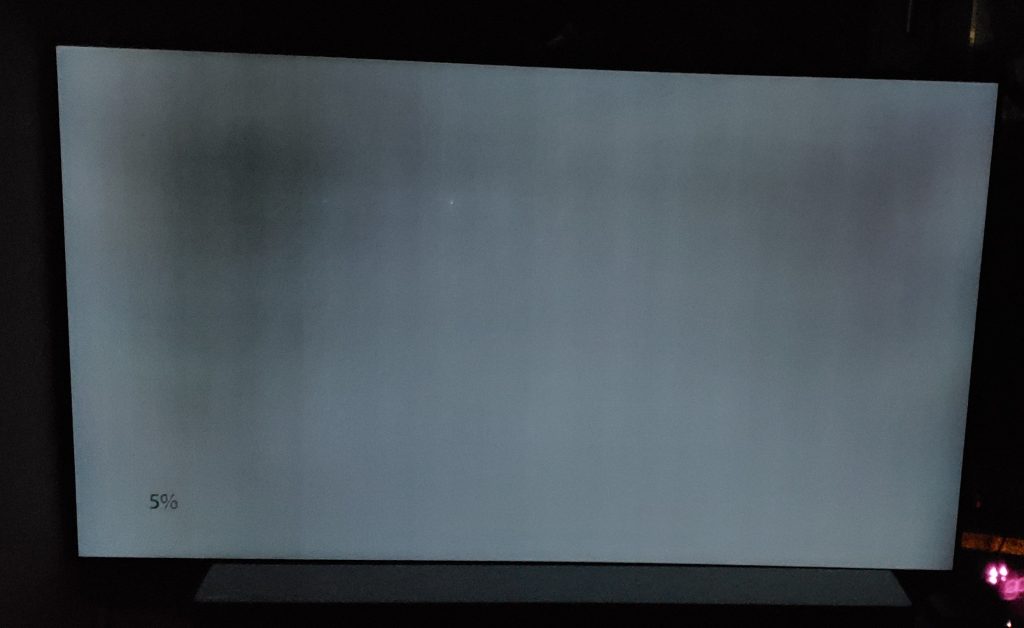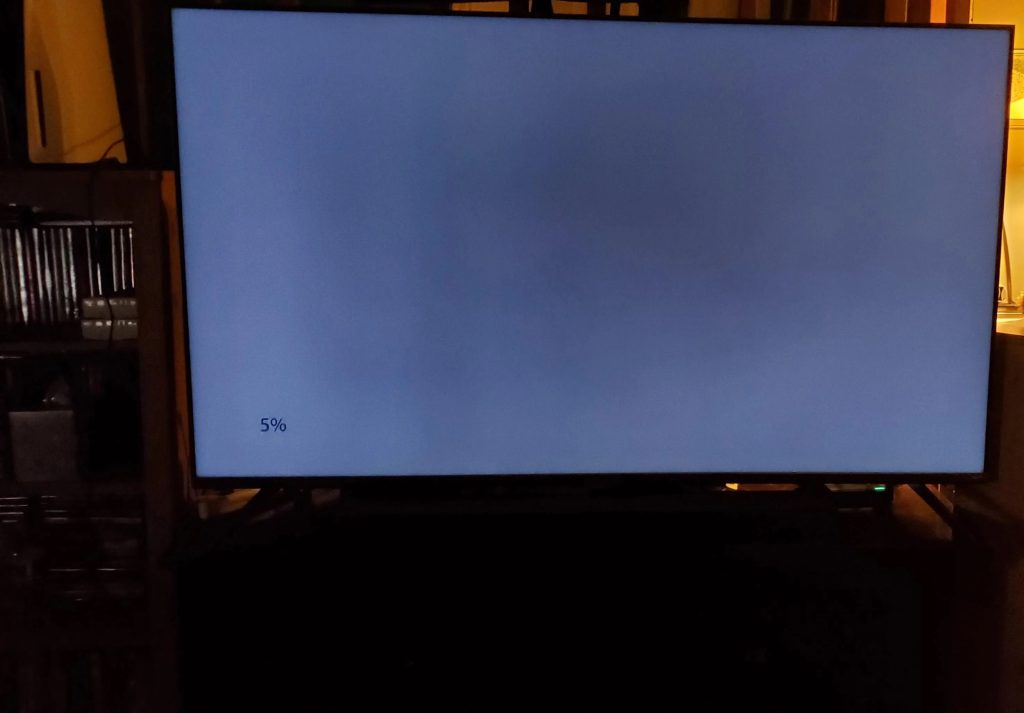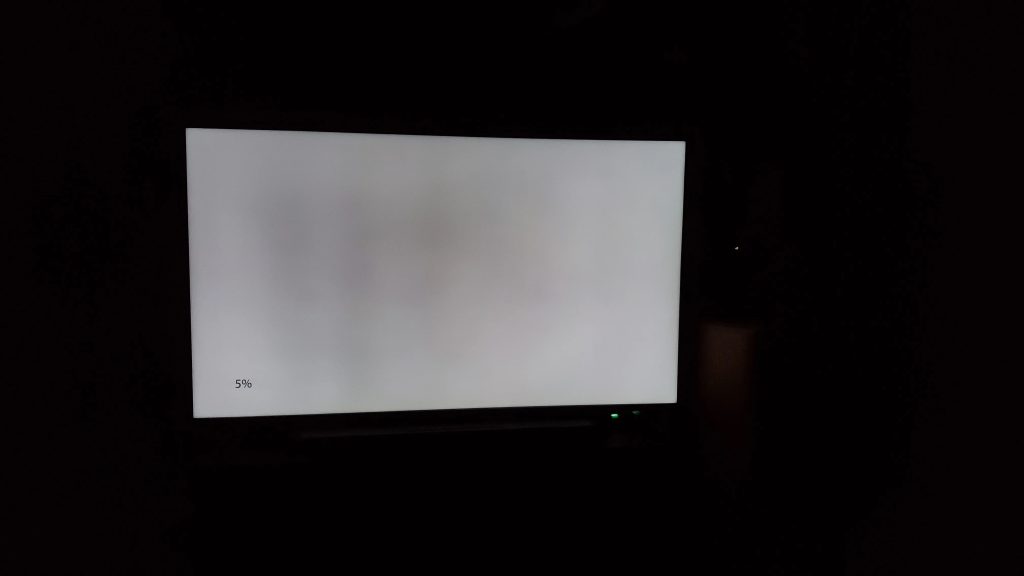Have you noticed dark spots, smudges, lines, or bars on your TV that you can’t wipe off with a cloth? Then you probably have a TV that has a Dirty Screen Effect (DSE). This issue results from an error in the manufacturing process or TV mishandling. You can’t really get rid of it, but you can soften the effect. Read this article to learn everything about it.
Dirty Screen Effect Appearance
A dirty screen effect (DSE) happens on an LCD panel with inconsistent luminance performance across its surface area. It is not an uncommon issue in LCD TVs. Unfortunately, you can’t eliminate it, but you can lessen the impact with color or brightness calibration or by changing the viewing angles.

What is Dirty Screen Effect?
Dirty Screen Effect (DSE) is inconsistent luminance performance across an LCD panel’s surface area. Basically, it is an uneven display of solid colors. It is most apparent when there is a black, gray, or white background. It is also visible when you watch sports or panning shots.
Usually, a dirty screen effect appears on LCD panels. All LED-backlit TVs can experience this issue, including QLED, and MiniLED panels, especially if they are Full Array. A similar effect can appear on OLED TVs when there is banding or a faulty panel.
The dirty screen effect usually doesn’t appear when you buy a TV — it typically appears after a while. It is most noticeable when you use full-screen solid colors or during very dark or very light scenes. Of course, it is clearly visible in very dark rooms.
What Does Dirty Screen Effect Look Like?
Dirty Screen Effect has a justified name. When your TV has this issue, it looks just like that —- dirty. It can appear in the form of wide bars, dark spots, uniform lines, or smudges. Sometimes this issue can appear as vignetting or dark corners of the TV screen.


Common Questions About Dirty Screen Effect
What Causes It?
Different factors can contribute to the appearance of a dirty screen effect on your LCD panel. However, most of them come down to faults in the manufacturing process.
Sub-pixel distribution can cause this problem. Variation in the conductivity and/or capacitance of transparent electrodes can also be the source of this issue. If it is hard for you to understand these technical terms, you should know that this problem boils down to one core issue — inconsistency.
Basically, DSE occurs because some pixels produce less brightness than others. Therefore, spots or lines crop up and cause a dirty screen effect.
Another thing that can cause this is the improper handling of the TV. It can happen during shipping or maybe during the installation of the TV. Make sure you avoid pressing the screen hard during installation, especially when you mount it on the wall, and only use light pressure when cleaning the TV.
You should also be aware of different quality control processes among manufacturers. As different manufacturers have different quality controls, a panel with a dirty screen effect can still appear in the market.
Is It a Common Occurrence?
You are probably wondering whether this issue is common. It is a surprisingly common phenomenon, especially regarding LCD screens.
However, it is important to point out that dirty screen effect has more chances of appearing on budget TVs. Manufacturers invest more time into solving this issue on high-end TV models. But, it doesn’t mean that high-end models don’t encounter this problem as well.
Can You Avoid It?
Unfortunately, if the issue is linked to the manufacturing process, you can’t avoid it. Therefore, it is crucial to catch this issue early on. So, if you notice your TV came with dirty screen effect, you should return it within the customer satisfaction period, which typically lasts for 30 days.
If you spot the problem during the warranty period, you can repair or replace your device.
In any case, if you want to avoid damage to the screen, try to handle your TV carefully when you clean it or move it around your home, and make sure you don’t press the screen too much.
How To Fix It
Color Calibration
You can perform a color calibration to adjust your TV to have the best possible picture. This can be done manually or with the help of a calibration disc. While you can do the calibration yourself, you can also hire an expert to do it for you.
In short, during this process, you can adjust all sorts of settings like sharpness, white balance, color, color temperature, contrast, etc. Color calibration can help make the dirty screen effect less visible.
Keep in mind that the best calibration results come when done by professionals. However, this service can cost a couple of hundreds of dollars — therefore, it might be a good idea to hire a professional if you have a high-end TV.
Clean the TV Screen
Another thing you can try is to actually clean the TV screen if it appears dirty. You can clean it to rule out the option that it could actually be dirty. If it clears up, then you solved the problem!
You need to be careful when cleaning your TV screen. You should only clean it with a microfiber cloth and water. Another solution is a mixture of water and dish soap.
However, never use aggressive cleaners that contain harsh chemicals such as alcohol, ammonia, or acetone. Here is what to do and what not to do when cleaning your TV screen.
Brightness Uniformity Compensation
Another way to ease dirty screen effect is with brightness uniformity compensation. This calibration process matches the problematic part of your TV panel to the brightness of the rest of the panel.

The result of the process is improved uniformity in brightness, which can help make dirty screen effect less visible.
Change the Viewing Angle
You can also try to change the viewing angle. The gray spots are more visible at a certain angle. If you watch your TV alone, try sitting right in front of the TV. The center viewing angle is always best.
Can You Test For DSE?
Dirty screen effect comes down to the question of gray uniformity. A gray uniformity test can give you an idea of how your TV performs when it comes to the evenness of solid colors. So, it shows you if the same color can be evenly displayed on your TV.
If the color uniformity is not good, you will notice the edges or the center of your TV being darker or just looking dirty. While watching content, however, you might not even notice dirty screen effect. For instance, it will be more visible with sports content because of the large areas of the same color.
Here is an interesting test you can run on your TV to see if there is a dirty screen effect. It also tests if there is blooming and burn-in:
50% Gray Picture
It tests uniformity on a 50% gray picture. So, this picture is between pure 0% black color and 100% pure white color. When the screen is halfway between pure black and pure white, it is easier to see the imperfections.
50% Standard Deviation
This test shows the average squared difference of color values of pixels when a 50% gray picture is on the whole screen. The lower the deviation, the better it is because there is not much deviation from the original color.
50% DSE
The 50% dirty screen effect is similar to the 50% standard deviation test. The only difference is that the 50% DSE tests the deviation at the center of the screen only.
5% Gray Picture
Again, this is similar to the 50% gray picture. As the name indicates, the 5% gray test also shows uniformity but on a darker image. This test is more effective on OLED TVs.
5% Standard Deviation
This is similar to the 50% standard deviation test, but it uses a 5% gray picture instead of the 50% gray one. Lower deviation is better when it comes to this test. This test matters when dark scenes are playing on your TV.
5% DSE
The 5% dirty screen effect is similar to the 50% DSE test. However, it matters for dark scenes as well, so it uses a 5% gray picture.
The Panel Lottery Explained
By now, it is common knowledge that TV manufacturers use outsourced panels for their products. A small number of companies produce TV panels. So, it is pretty common that different units of the same TV model have different panels made by different companies.
What does this mean for the end-user? Basically, when you purchase a TV model, you can’t know what kind of panel you will get. So, the panel lottery is called a lottery for a reason.
You can buy two TVs of the same model, and they could have different panels. As a result, you can get two TVs with different contrast ratios, different motion blur handling, different input lag, etc.
Therefore, there are differences between individual panels, but they are minor. So, the panel lottery is not really something to be worried about.
In terms of the dirty screen effect, the panel lottery also means you play a lottery each time you buy a TV. You have no way of knowing what condition your panel is going to be in. Some lucky buyers get the perfect panel that shows no signs of a dirty screen effect.
Some buyers, on the other hand, get a faulty panel that shows the signs of this issue right away, from the moment they take the TV out of its box.
Frequently Asked Questions
Is dirty screen effect noticeable?
It depends on the content you are watching. If you have a dirty screen effect on your TV, it is more visible when there is a gray, black, or completely white background on your screen. It is also visible if the content has large areas of the same color, for example, sports broadcasts such as hockey or soccer.
Can you fix dark spots on your TV?
Unfortunately, the dark spots, smudges, or lines causing the dirty screen effect can only be slightly improved but not completely fixed. You can adjust the color or calibrate the brightness or simply change the viewing angle. You can’t get rid of the dirty screen effect. The only way out is to buy a new TV.
Does OLED uniformity improve?
There are a couple of things you can try to improve the state of the dirty screen effect like color calibration, changing the viewing angle, or brightness uniformity compensation. However, don’t expect it to improve on its own. On the contrary, you can expect the dirty screen effect to get worse over time as your TV gets older.
What causes a dark shadow on the TV screen?
Dark shadows, lines, or smudges on the screen happen when a screen doesn’t have uniformity or balance in displaying color. When this happens, the light levels are uneven. It usually comes down to errors in the manufacturing process or improper handling of the TV during the shipping or installation process.
Conclusion
Dirty Screen Effect (DSE) is basically an uneven display of solid colors on your TV panel. It mostly occurs on LED panels. QLED, MiniLED, and even OLED panels are prone to this problem.
The DSE can appear as dark spots, smudges, lines, wide bars, or even dark corners, known as vignetting. The cause of this problem usually comes down to sub-pixel distribution, making the brightness levels on your TV inconsistent. If your TV was mishandled during the installment of shipping, that could also cause the DSE.
Unfortunately, you can’t avoid this issue, but if you encounter it on your TV, you could soften the effects. You can start by cleaning your screen and checking if the screen is actually dirty or not. Then you could do color calibration, brightness adjustment, or simply change the viewing angles.
Keep in mind that many people don’t even notice the problem until they actually test the gray uniformity. However, if it really bothers you, you might want to look at purchasing a new TV.